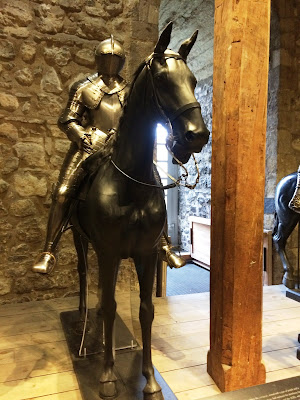 |
| The old and the new: Lynne, the Tower of London and the new London |
I was standing in the immense St. John Catholic Church, in Bath, England, swallowed up by its towering dimensions. I was looking skyward at the ornate floral ceiling. The church had been bombed during WWII. I was right by the regally red and gold altar where one of the two curates had died in the bombing. I reflected on the reconstruction of the magnificent windows. I had a “Wow!” feeling. Amazement that I was there where the bombing had taken place, bringing me closer to yet another moment of the WWII story, a story that speaks to my soul. That was Sunday, October 1, 2017.
 |
| The display depicting Churchill in his War Room office |
We attended Evensong at the landmark St. Paul’s Cathedral, also bombed earlier in WWII, now fully restored as well.
But in the timeline of English history, WWII is “just yesterday.” My perspective on "old" stretched considerably. The Tower of London, where Lynne and I spent several hours, was built after William conquered England in 1066. The Tower had various uses, including as a royal residence, but its infamy comes from having been a state prison from 1066 until 1956. I came home with many photos from the seemingly endless display of shiny, bestudded military armor worn by British soldiers and horses, dating back to 1535. Outside on the green, the Yeoman Warder pointed out the probable spot where Henry VIII had Ann Boleyn beheaded in 1536.
Just one of many examples of armor at the Tower of London
 |
| Recognize this from Harry Potter? It is the actual dining hall at Christ Church College in Oxford |
Yet we were still in modern times, compared to the Roman Baths, in Bath, constructed during the Roman occupation of Britain beginning in 60 AD. Lynne and I walked on the worn stone pathways, around the green-yellow pools of hot mineral water, still bubbling up after thousands of years. We saw the plumbing and drainage system on the lower level, following the stream from its intake to the soaking pools to its final exit. Remnants of the temple of the goddess Sulis-Minerva were on display. The display cases included curse tablets, small pieces of lead inscribed with messages imploring the goddess to curse those who had wronged the author. We also had an upclose view of Roman artifacts a few days earlier in Cirencester. built over the Roman town of Corinium. Extensive and elaborate mosaics have been recovered and put on display in their excellent museum. Ironically, a local regimen of British soldiers marched through the streets of Cirencester as part of the town’s 900th birthday celebration on the day we visited the town.
But none of that is really old. OK, now go back another 2000 years, to 2000 BC. We went to the Blue Hills Tin Streams in Cornwall, where tin had been mined for 4000 years. Yes, think Poldark. We hiked down (and later back up!) a long steep hill to stand next to the stream which flows through the last remaining tin operation. The owner no longer employs female manual laborers (“Bal Maidens”) to” bust” rocks, but the midden of discarded rocks that rose from the hillside beside us gave witness to their work. He no longer mined the seam underground, but I could see the smudged and begrudging faces of the miners who did in a display of old photographs.
Abandoned buildings at tin mine in Cornwall
And then I thought about Stonehenge, whose construction started in 3100 BC.
The human English history that I witnessed spans 5000 years, a greater defnition of the word "old" than I, living in North America, am used to seeing. England, a country the same size as Oregon, bears witness to its history at every turn, and I had only taken a few of those turns.
I'm still not done with "How old is old?" Lynne and I are younger than Stonehenge but feel OLD (69 and 66 years in these bodies).
Before our trip, we had consoled ourselves that the other hikers on our Road Scholar trip would not put us to shame, since they would likely be our age or or even older. We were correct in that we were among the youngest members on the trip. As far as we could tell, the oldest was in his eighties.
But these oldsters were consistently passing us on the trails in the Cotswolds and Cornwall. I would hear a polite “On your left!” or I would sense someone breathing down my neck as I cautiously slowed to a crawl on a slippery down hill.
I would never have picked out my fellow Road Scholars as athletes. They looked like a typical group of well nourished, underfashioned American tourists, with their REI daypacks, nature colored rainsuits and collapsible hiking poles. They were not wearing spandex nor did they have Olympic medals around their necks, yet they inspired us to greater adventures.
This sculpture representing the legendary King Arthur sits high on the Cornish bluffs overlooking the Atlantic Ocean at Tintagel. I like the juxtaposition of the stone bluff, the Atlantic Ocean, and the semi-substantial figure of King Arthur.

















